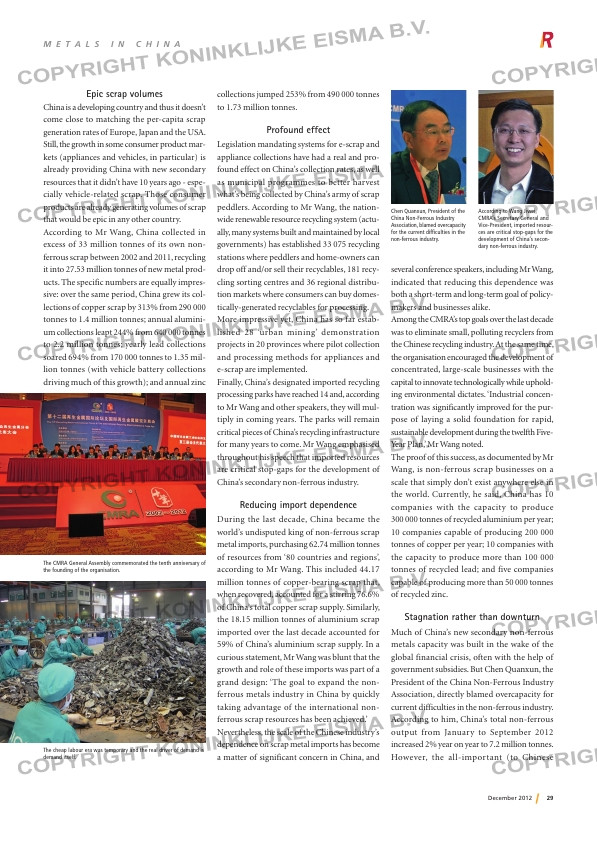Page 29 from: December 2012

29December 2012
M e t a l s i n c h i n a
Epic scrap volumes
China is a developing country and thus it doesn’t
come close to matching the per-capita scrap
generation rates of Europe, Japan and the USA.
Still, the growth in some consumer product mar-
kets (appliances and vehicles, in particular) is
already providing China with new secondary
resources that it didn’t have 10 years ago – espe-
cially vehicle-related scrap. Those consumer
products are already generating volumes of scrap
that would be epic in any other country.
According to Mr Wang, China collected in
excess of 33 million tonnes of its own non-
ferrous scrap between 2002 and 2011, recycling
it into 27.53 million tonnes of new metal prod-
ucts. The specific numbers are equally impres-
sive: over the same period, China grew its col-
lections of copper scrap by 313% from 290 000
tonnes to 1.4 million tonnes; annual alumini-
um collections leapt 244% from 640 000 tonnes
to 2.2 million tonnes; yearly lead collections
soared 694% from 170 000 tonnes to 1.35 mil-
lion tonnes (with vehicle battery collections
driving much of this growth); and annual zinc
collections jumped 253% from 490 000 tonnes
to 1.73 million tonnes.
Profound effect
Legislation mandating systems for e-scrap and
appliance collections have had a real and pro-
found effect on China’s collection rates, as well
as municipal programmes to better harvest
what’s being collected by China’s army of scrap
peddlers. According to Mr Wang, the nation-
wide renewable resource recycling system (actu-
ally, many systems built and maintained by local
governments) has established 33 075 recycling
stations where peddlers and home-owners can
drop off and/or sell their recyclables, 181 recy-
cling sorting centres and 36 regional distribu-
tion markets where consumers can buy domes-
tically-generated recyclables for processing.
More impressive yet, China has so far estab-
lished 28 ‘urban mining’ demonstration
projects in 20 provinces where pilot collection
and processing methods for appliances and
e-scrap are implemented.
Finally, China’s designated imported recycling
processing parks have reached 14 and, according
to Mr Wang and other speakers, they will mul-
tiply in coming years. The parks will remain
critical pieces of China’s recycling infrastructure
for many years to come. Mr Wang emphasised
throughout his speech that imported resources
are critical stop-gaps for the development of
China’s secondary non-ferrous industry.
Reducing import dependence
During the last decade, China became the
world’s undisputed king of non-ferrous scrap
metal imports, purchasing 62.74 million tonnes
of resources from ‘80 countries and regions’,
according to Mr Wang. This included 44.17
million tonnes of copper-bearing scrap that,
when recovered, accounted for a stirring 76.6%
of China’s total copper scrap supply. Similarly,
the 18.15 million tonnes of aluminium scrap
imported over the last decade accounted for
59% of China’s aluminium scrap supply. In a
curious statement, Mr Wang was blunt that the
growth and role of these imports was part of a
grand design: ‘The goal to expand the non-
ferrous metals industry in China by quickly
taking advantage of the international non-
ferrous scrap resources has been achieved.’
Nevertheless, the scale of the Chinese industry’s
dependence on scrap metal imports has become
a matter of significant concern in China, and
several conference speakers, including Mr Wang,
indicated that reducing this dependence was
both a short-term and long-term goal of policy-
makers and businesses alike.
Among the CMRA’s top goals over the last decade
was to eliminate small, polluting recyclers from
the Chinese recycling industry. At the same time,
the organisation encouraged the development of
concentrated, large-scale businesses with the
capital to innovate technologically while uphold-
ing environmental dictates. ‘Industrial concen-
tration was significantly improved for the pur-
pose of laying a solid foundation for rapid,
sustainable development during the twelfth Five-
Year Plan,’ Mr Wang noted.
The proof of this success, as documented by Mr
Wang, is non-ferrous scrap businesses on a
scale that simply don’t exist anywhere else in
the world. Currently, he said, China has 10
companies with the capacity to produce
300 000 tonnes of recycled aluminium per year;
10 companies capable of producing 200 000
tonnes of copper per year; 10 companies with
the capacity to produce more than 100 000
tonnes of recycled lead; and five companies
capable of producing more than 50 000 tonnes
of recycled zinc.
Stagnation rather than downturn
Much of China’s new secondary non-ferrous
metals capacity was built in the wake of the
global financial crisis, often with the help of
government subsidies. But Chen Quanxun, the
President of the China Non-Ferrous Industry
Association, directly blamed overcapacity for
current difficulties in the non-ferrous industry.
According to him, China’s total non-ferrous
output from January to September 2012
increased 2% year on year to 7.2 million tonnes.
However, the all-important (to Chinese
According to Wang Jiwei,
CMRA’s Secretary General and
Vice-President, imported resour-
ces are critical stop-gaps for the
development of China’s secon-
dary non-ferrous industry.
Chen Quanxun, President of the
China Non-Ferrous Industry
Association, blamed overcapacity
for the current difficulties in the
non-ferrous industry.
The CMRA General Assembly commemorated the tenth anniversary of
the founding of the organisation.
The cheap labour era was temporary and the real driver of demand is
demand itself.
RI_10-CMRA.indd 29 03-12-12 09:09



